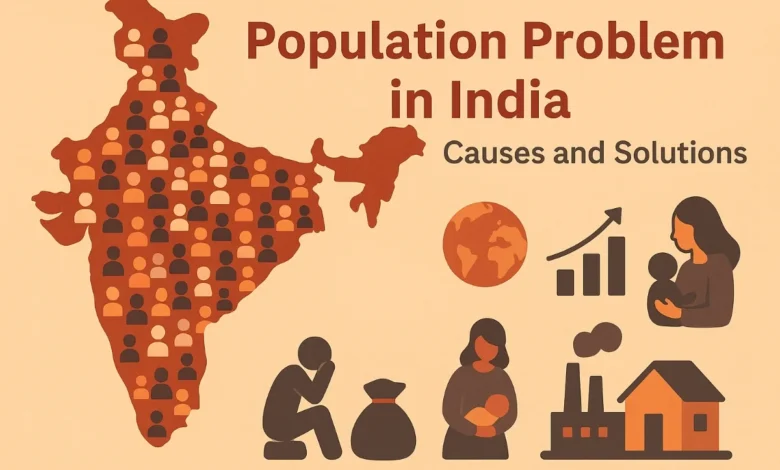Population Problem in India Compsition For All Classes of Students

Introduction
India’s population problem is a combination of multiple social, economic, and environmental factors. Simply put: India’s population is growing rapidly, putting pressure on infrastructure, education, health, and the environment. In this article, we will analyze the issues, including causes, effects, and solutions, so that you can understand the issue intelligently.
The Population Problem in India
Current picture of India’s population
- India’s population in 2023 is 1.438 billion.
- There is a slight slowdown in population growth, but the density and growth rate are still of concern.
Mini-Summary: India’s population is very large, and the way it grows is clear that it is creating various challenges.
Causes of Population
High birth rate and developmental inequality
- Even though the population is growing rapidly in some states, those regions are lagging in education-health-family planning.
- Co-factors include: lack of female education, reduced job opportunities, and rural-modern inequality.
Mini-Summary: It is not just numbers, it is about people’s lives — lack of education, health, and opportunities are the root causes of population problems.
Urbanisation and increasing density
- The rate of urbanisation in India is increasing with the population growth; the share of the population living in urban areas is expected to increase between 2005 and 2050.
- Increasing density creates pressures on housing, water and waste management, transport, and the environment.
Mini-Summary: More people are moving to cities, and cities are not able to cope with this pressure properly.
Impact analysis
Economic and employment impacts
- Even though the working-age population is large, the ‘demographic dividend’ may be lost if good employment opportunities are not created.
- India has low female participation in the labour market, which further exacerbates the problem.
Mini-Summary: Even though there are many people, if they are not given work, it becomes a burden on society and the economy.
Education, health, and environmental pressures
- There is a growing pressure on health and education services.
- Environment and resources such as water, land, and transport are rapidly reaching their limits.
Mini-Summary: The Population is putting a constant strain on the essential services and environment of society.
Solutions to India’s population problem
Improvements in family planning and health
- Improvements in women’s education and health services are effective in controlling the population.
- There is a need to increase government policies and awareness.
Mini-Summary: Significant improvements are possible through enhancements in education and healthcare services.
Increasing employment and women’s participation
Mini-Summary: It is not just the population that is growing—the biggest challenge is to employ people.
- By creating productive employment opportunities, especially for women, demographic trends can be converted into economic growth.
Urban planning and environmental sustainability
- Improvements in urban planning, housing, transport, and waste management are essential.
Mini-Summary: Proper planning of cities can reduce population pressure.
Conclusion
India’s population problem is no longer just a matter of numbers—it is a complex challenge that encompasses education, health, economic opportunity, urbanization, and the environment. Without timely and effective policies and implementation, this challenge will not be manageable. Therefore, this executive action is crucial for India.
India’s population growth and economic development data (World Bank).
Read Environment Pollution Composition
India’s population is increasing due to improved healthcare, reduced mortality rates, and a lack of awareness about family planning in certain regions.
Yes. Overpopulation creates pressure on resources, employment, education, healthcare, and the environment, leading to multiple social and economic challenges.
Education, women’s empowerment, effective family planning, and better healthcare policies are key to managing population growth.
If sufficient jobs are not created for the growing population, it becomes a burden rather than an advantage, harming economic growth.
No. Both rural and urban areas face population challenges—rural areas suffer from a lack of education and awareness, while cities face overcrowding and infrastructure pressure.
More population means greater use of natural resources like water, land, and energy, resulting in pollution and environmental degradation.
The Indian government runs family planning campaigns, promotes women’s education, and encourages small family norms through awareness programs.